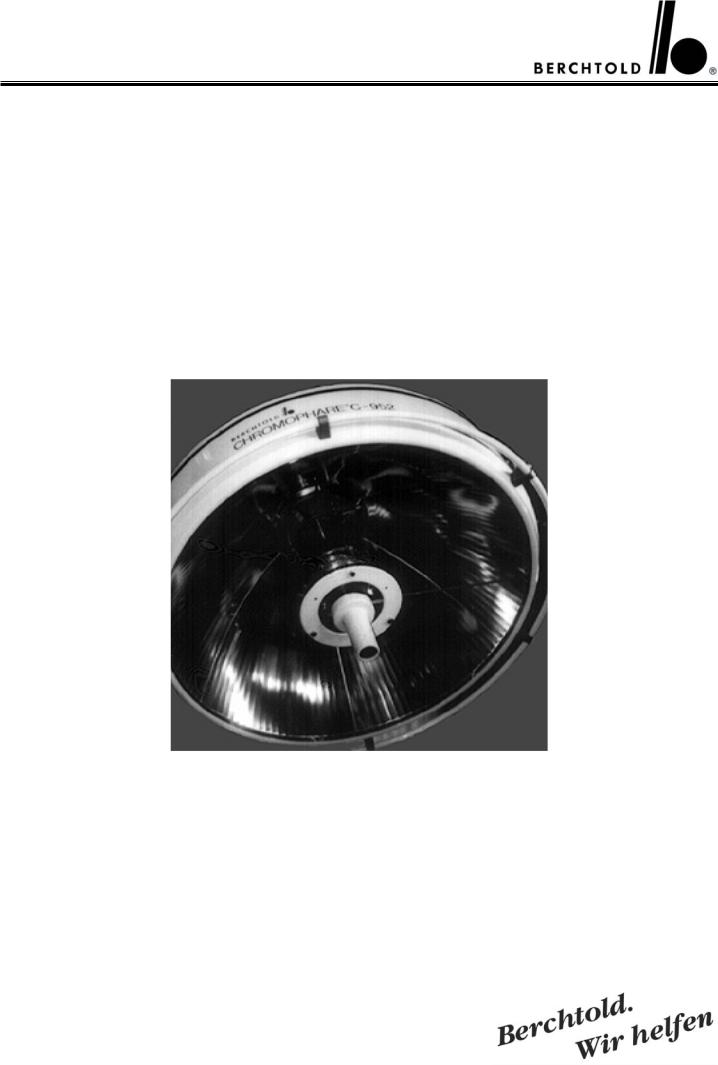Berchtold Chromophare C952 Service manual

CHROMOPHARE® C 952
Service-Manual (D, E)

Inhaltsverzeichnis |
Themen |
Seite |
|
für Service-Manual |
Einführung |
|
4 |
C 952 |
|
||
Technische Daten |
|
5 |
|
|
|
||
|
Schaltungsbeschreibung |
7 |
- 13 |
|
Ersatzteilliste |
14 |
- 16 |
|
Bildliche Ersatzteildarstellung |
17 |
- 29 |
|
Meßpunkte |
|
30 |
|
Einstellpunkte |
|
31 |
|
Einstellpunkte in Verbindung mit dem Diagnosestecker |
|
32 |
|
Einstellen des Gewichtsausgleichs |
33 |
- 34 |
|
Einstellung der Federkennlinie |
34 |
- 35 |
|
Anschlußplan |
|
|
|
Transformatoren am Deckenrohr der Leuchte |
|
36 |
|
Anschlußplan Transformatoren und |
|
|
|
Notstromumschaltrelais am Deckenrohr der Leuchte |
|
37 |
|
Anschlußplan |
|
|
|
Transformatoren separat im bauseitigem Wandschaltkasten |
|
38 |
|
Anschlußplan Transformatoren und Notstromumschaltrelais |
|
|
|
separat im bauseitigem Wandschaltkasten |
|
39 |
|
Sicherungen |
|
40 |
2 |
CHROMOPHARE® C 952 Service Manual (D, E) |

Table of contents for Service-Manual C 952
Contens |
Page |
|
Introduction |
|
4 |
Technical Data |
|
6 |
Functional Description |
7 |
- 13 |
Spare Part List |
14 |
- 16 |
Graphic spare part description |
17 |
- 29 |
Measuring Points |
|
30 |
Adjustment Points |
|
31 |
Adjustment by use of diagnostic plug |
|
32 |
Adjusting the Weight Counter Balance |
33 |
- 34 |
Adjustment of the Spring Characteristic |
34 |
- 35 |
Electrical Diagram |
|
|
Transformers mounted on the ceiling tube |
|
36 |
Electrical Diagram |
|
|
Transformers and emergency relays mounted on the ceiling tube |
|
37 |
Electrical Diagram |
|
|
Transformers mounted in a wall box on side of building |
|
38 |
Electrical Diagram Transformers and emergency relais mounted in a |
|
|
wall box on side of building |
|
39 |
Fuses |
|
40 |
CHROMOPHARE® C 952 Service Manual (D, E) |
3 |

Einführung
Introduction
CHROMOPHARE® C 952 Brillant
Noch mehr Licht im OP-Feld
•Mit neuentwickelter Reflektrotechnik ein Maximum an Lichtausbeute
•Einzigartige Brillantoberfläche der Reflektorsegmente
•Mehr Licht, weniger Streuung durch die klare Lichtaustrittsfläche
•Keine zusätzliche Wärmebelastung
•Unveränderte, bewährte CHROMOPHARE® Beleuchtungstechnologie
•Entspanntes, augenschonendes Arbeiten im OP-Feld
CHROMOPHARE® C 952 Brilliant
Brighter light at the surgical site
•Maximum light efficiency with improved reflector technology
•Unique brilliant surface of reflector segments
•Increased intensity via clear light emission surface
•ThermoSorb® filter keeps it cool
•Proven CHROMOPHARE® lighting technology
4 |
CHROMOPHARE® C 952 Service Manual (D, E) |

Technische Daten Berchtold CHROMOPHARE® Operationsleuchte C 952
Elektrische Anschlußdaten Trafo |
110/115/120/220/230/240 Volt, 450 VA |
Gleichspannung |
24,4 V - 30,0 V/max. 16 A |
Wechselspannung |
23 V - 30 V ~ |
Beleuchtungsstärke in 1 m Abstand |
|
bei Farbtemperatur 4.500 K |
150.000 Lux |
bei Farbtemperatur 3.600 K |
200.000 Lux |
Durchmesser des Polygon-Reflektors |
870 mm |
Durchmesser des Leuchtengehäuses |
950 mm |
Licht-Austrittsfläche |
90 % der Leuchten-Unterseite |
Durchmesser kleines Lichtfeld |
200 mm |
Durchmesser großes Lichtfeld |
350 mm |
Lichtfeld-Verstellung |
stufenlos mit Servomotor |
Gleichbleibender Lichtfeld-Durchmesser ohne Nachfokussierung konstant bis |
800 mm Höhen-Differenz |
Hauptlichtquelle 1 Halogenlampe |
250 Watt / 22,8 V, Artikel Nr. CZ 907-22 |
Reservelichtquelle 1 Halogenlampe |
250 Watt / 22,8 V, Artikel Nr. CZ 907-22 |
Automatische Umschaltung auf Reservelicht bei Defekt der Hauptlichtquelle |
mit optischer Anzeige |
Mittlere Lebensdauer der Halogenlampe |
ca. 1000 Brennstunden |
Aktionsradius der Fahrbahn |
1950 mm |
Höhenverstellung des Leuchtenkörpers |
1150 mm |
Elektrik entsprechend den Sicherheitsstandards-Standards nach VDE und IEC |
|
CHROMOPHARE® C 952 Service Manual (D, E) |
5 |

Berchtold CHROMOPHARE® Surgical Lights C 952
Power requirements Transformer |
110/115/120/220/230/240 V, 450 VA |
Direct voltage |
24,4 V - 30,0 V/max. 16 A |
Alternating voltage |
23 V - 30 V ~ |
Illuminance measured at 1 m distance: |
|
with colour temperature 4.500 K |
150.000 Lux |
with colour temperature 3.600 K |
200.000 Lux |
Diameter of polygon reflectors |
870 mm |
Diameter of lamp housing |
950 mm |
Light emission surface |
90 % of light underside |
Diameter of small light field |
200 mm |
Diameter of large light field |
350 mm |
Light field adjustment |
infinitely variable with servomotor |
Constant light field diameter without focussing |
constant up to 800 mm difference in height |
Main light source |
250 Watt / 22,8 V, article no. CZ 907-22 |
Reserve light source |
250 Watt / 22,8 V, article no. CZ 907-22 |
Automatic switching of reserve lamp |
with visual indication |
Average service life of halogen lamp |
approx. 1000 hours |
Swivel radius of lamp housing |
1950 mm |
Height adjustment of lamp housing |
1150 mm |
Electrical system in accordance with VDE and IEC standards |
|
6 |
CHROMOPHARE® C 952 Service Manual (D, E) |

Schaltungsbeschreibung der Berchtold
CHROMOPHARE®
Operationsleuchte C 952
Functional Description of the
Berchtold
CHROMOPHARE®
C 952 Operating Light
Stromversorgung und Notstromumschaltung
Die Netzspannung wird über einen Hauptschalter über die Sicherungen F 7 und F 8 an den Transformator Tr 1 gelegt, der für verschiedene Betriebsspannungen umschaltbar ist. Sobald Trafo T 1 sekundärseitig Spannung erzeugt, zieht Relais K 9 an und legt die pulsierende Gleichspannung an die Federgelenkelektronik (über Kontakt K 91 und K 92).
Bei Ausfall der Netzspannung geht das Relais K 9 in Ruhestellung zurück, über die Ruhekontakte von Relais K 9 wird die Notstromversorgung an die Leuchte geschaltet. Die Notstromversorgung wird durch die Sicherungen F 9 und F 10 abgesichert.
Achtung!
Die Notversorgung (battery) wird über den Leistungsbrückengleichrichter V 1 geführt. Dies bewirkt einen Spannungsabfall von ca. 1,5 V D.C.. Durch diese Maßnahme ist die Leuchte bei Gleichspannungsanschluß verpolungssicher.
Ein/Aus-Schaltung der Leuchte
Über Relais K 3 wird die Operationsleuchte einund ausgeschaltet. Relais K 3 befindet sich auf der Hauptplatine der Federgelenkelektronik. Es ist ein bistabiles Relais, das sich nach Aktivierung in der jeweiligen Stellung selbst hält.
Automatische Reservelichtumschaltung
Beim fehlerfreien Zustand der Operationsleuchte ist Hauptlampe H 1 in Betrieb. Fällt die Hauptlampe H 1 aus, reagiert der Stromsensor L 8 und die Reservelampe H 2 wird von Relais K 4 eingeschaltet. Solange die Leuchte in Betrieb ist, bleibt die Reservelampe stromdurchflossen. Die Hauptlampe kann nur wieder über ein Ausund Einschalten der Leuchte aktiviert werden.
Power supply and Emergency changeover
The supply voltage is connected across transformer Tr 1 via fuses F 7 and F 8 by means of a main switch; Tr 1 can be changed over to different operating voltages. As soon as transformer T 1 generates secondary voltage, relay K 9 picks up and contacts the pulsating direct voltage across the spring-balanced joint electronics ( viacontacts K 91 and K 92).
In case of supply voltage failure, relay K 9 returns to neutral position, and the emergency power supply is connected to the light via the break contact of relay K 9. The emergency power supply is protected by fuses F 9 and F 10.
Attention!
The emergency power supply (battery) is conducted via bridge rectifier V 1. This results in a voltage drop of approx. 1,5 V D.C.. This ensures that the light is protected against reversed polarity when operating on D.C. voltage.
Switching the light on/off
The operating light is switched on and off via relay K 3. Relay K 3 is located on the main circuit board of the springbalanced joint electronics. It is a bistable relay which remains in position by itself after activation.
Automatic activation of reserve lamp
When the operating light is in perfect operating order, main lamp H 1 is in operation. In case of failure of main lamp H 1, current sensor L 8 responds, and reserve lamp H 2 is switched on by relay K 4.
The reserve lamp remains energized the entire time the operating light is in operation. The main lamp can be reactivated only by switching the light off and on again
CHROMOPHARE® C 952 Service Manual (D, E) |
7 |

Achtung!
Ein gleichzeitiger Betrieb beider Lampen wird ausgeschlossen. Bei Umschaltung auf Reservelicht ist die elektronische Regelung komplett abgeschaltet! Eine Helligkeitsverstellung (hell-dunkel) ist nicht mehr möglich. Das Reservelicht wird über einen Vorwiderstand von der Betriebsspannung direkt versorgt. Stufe 1 der Balkenanzeige auf der Tastatur wird angezeigt. Gleichzeitig leuchtet das Symbol "Hauptlampe defekt" auf der Tastatur rot auf. Die Bauteile zum Auslösen der Reservelampenanzeige befinden sich auf der Deckenplatine, Teile Nr. 51878, IC 25 und V 10.
STOP-Funktion der Lichtfeldnachführung:
Wir die Taste S 7 gedrückt, schaltet das bistabile Relais K 8. Dieses Relais unterbricht die Stromzuführung für die Platine 11 und 14, die beide im Leuchtenkörper montiert sind. Platine 11 und 14 sind für die Steuerung von Lichtfeldnachführung und Autobloc verantwortlich. Rückgesetzt wird das Relais K 8 wieder durch die Schalter S 5 bzw. S 6 (Ein/Aus). Alle weiteren Funktionen der Leuchte (wie Helligkeitsregelung, Verstellung des Lichtfelddurchmessers, Reservelampenanzeige) bleiben davon unberührt.
Attention!
Simultaneous operation of the lamps is not possible. When the reserve lamp is activated, the electronic control system is deactivated! Adjustment of light intensity (bright-dark) is no longer possible. The reserve lamp is fed directly from the operating voltage via a protective resistor. Stage 1 of the bar indicator on the control pad is shown. At the same time, the red "main lamp defect" symbol on the control pad is indicated. The components which trigger the reserve lamp indicator are located on the upper circuit board, part no. 51878, IC 25 and V 10.
The light field guidance STOP function:
When key S 7 is pressed, the bistable relay K 8 ist connected. This relay interrupts the current supply for circuit board 11 and 14 are responsible for the control of light field guidance and the Autobloc function. Relay K 8 is returned to initial position by means of key S 5 or S 6 (on/off). All other functions of the light (such as intensity control, adjustment of the light field diameter, reserve lamp indicator ...) are not affected by the STOP function.
Balkenanzeige der Helligkeitsregulierung:
Der Sollwert der Lampenspannung wird von Widerstand R 2 des Motorpotentiometers M 5 auf der Grundplatine abgenommen. Diese Spannung wird zuerst einem Impedanzwandler und danach einem weiteren Operationsverstärker zugeführt, der für die Anpassung des Leuchtbandes sorgt. Diese beidenKomponenten sind beide Bestandteile des IC 9. Die restlichen Operationsverstärker von IC 9 und IC 10 stellen in Verbindung mit den Widerständen R 78 - R 82 Schwellwertschalter dar, die für eine folgerichtige Ausleuchtung des Leuchtbandes sorgen.
Bar indicator for light intensity control:
The set value for lamp voltage is picked up by resistor R 2 of the motor potentiometer M 5 on the lower circuit board. This voltage is first fed to an impedance converter, and then to a further operational amplifier, which is responsible for aligning the luminos band. These two components belong both to IC 9. In combination with resistors R 78 - R 82, the remaining operational amplifiers belonging to IC 9 and IC 10 serve as threshold value switches which ensure consistent illumination of the luminous band. In this connection, trimmer resistor R 28 is responsible for the correct transmission range of the output voltage of the luminous band.
8 |
CHROMOPHARE® C 952 Service Manual (D, E) |

Der Trimmerwiderstand R 28 sorgt in diesem Zusammenhang für den richtigen Übertragungsbereich der Eingangsspannung des Leuchtbandes. Mit dem Trimmerwiderstand R 30 kann die untere Pegelschwelle des Leuchtbandes eingestellt werden. Trimmerwiderstand R 28 und R 30 befinden sich zusammen mit den entsprechenden Logikbausteinen IC9 und IC 10 auf der Deckenplatine, während die Sollwertspannung auf der Grundplatine erzeugt wird.
Leuchtfeld "electronic" (Folientastatur):
Wird die Taste S 7 (Stop) gedrückt, zieht das bistabile Relais K 7 an. Der Kontakt K 7 wird geschlossen und legt eine Spannung von ca. 25 Volt an das Leuchtfeld. Die Anzeige "electronic" auf der Folientastatur leuchtet auf. Die Autoblocfunktion sowie die Lichtfeldnachführung sind dann nicht aktiviertbar. Rücksetzen läßt sich das Relais K 7 durch Betätigen der Ein-Taste (S1).
Automatische Reservelichtumschaltung: Im Falle eines Lampendefekts wird über IC 25 ein Signal an Transistor V 10 gegeben - es leuchtet das Symbol der "Hauptlampe defekt" (8) auf. Die weiteren Bauteile zur Ansteuerung dieser Elektronik befinden sich auf der Hauptplatine.
Sollwerterzeugung für die Helligkeitseinstellung
Links - und Rechtslauf des Motorpotentiometers M 5
Die Spannung für den Sollwert der Helligkeit wird aus dem IC N 1 erzeugt. IC N 1 liefert eine konstante Spannung von ca. 12,8 V, die einem Trimmwiderstand R 1 zugeführt wird Dieser Trimmwiderstand R 1 befindet sich auf der Hauptplatine und bildet mit dem Widerstand R 2 einen Spannungsteiler. Er ermöglicht die Einstellung der Fenstermitte der möglichen Ausgangsspannungen. Durch Betätigen der Tasten S 1 bzw. S 2 werden IC 11 oder IC 12 aktiviert. IC 11 und IC 12 werden von IC N 1 mit einer konstanten Spannung von 12,8 V gespeist.
In this connection, trimmer resistor R 28 is responsible for the correct transmission range of the output voltage of the luminous band. The lower threshold level of the luminous band can be set with trimmer resistor R 30. Trimmer resistors R 28 and R 30 are located on the upper circuit board, together with the corresponding logical units IC 9 and IC 10; set voltage is generated on the lower circuit board.
"Electronic" light field (Foil control panel):
Bistabile relay K 7 picks up when key S 7 (stop) is pressed. Contact K 7 is closed and supplies a voltage of 25 V to the light field. The "electronic" indicator on the control panel lights up. The Autobloc and light field guidance functions now cannot be activated. Relay K 7 can be returned to initial position by pressing the on or off switch.
Automatic activation of reserve lamp: In case of lamp failure, a signal is transmitted to transistor V 10 via IC 25; the "main lamp defect" (8) symbol then lights up. Further components necessary to employ this electronic assembly are located on the main circuit board.
Set value generation for light intensity control
Counter-clockwise and clockwise rotation of motor potentiometer M 5
Voltage for the set value for light intensity is provided form the IC N 1. IC N 1 supplies a constant voltage of approx.
12,8 V, which is fed to trimmer resistor R 1. Trimmer resistor R 1 is located on the main circuit board and, together with resistor R 2, forms a voltage divider. Trimmer resistor R 1 allows adjustment of the window centre of the possible output voltages. By pressing key S 1 or S 2, IC 11 or IC 12 is activated. IC 11 and IC 12 are supplied with a constant voltage of 12,8 V by IC N 1. If IC 11 or IC 12 is activated,
CHROMOPHARE® C 952 Service Manual (D, E) |
9 |

Ist IC 11 bzw. IC 12 aktiviert, kommt es zum Linksbzw. Rechtslauf des Motorpotentiometers, welches die Sollwerspannung über den Widerstand R 2 einstellt. Die Sollwertspannung wird der Regelungsplatine für die Helligkeitseinstellung, Teile Nr. 50892 zugeführt.
Variable Bereichseingrenzung der Helligkeitseinstellung:
Die Bauteile IC 7, IC 8, V 4, V 5, K 2 und K 1 stellen die Elemente für die Bereichseingrenzung der Helligkeitseinstellung dar. Mit den Trimmwiderständen R 20 und R 23 wird die Bereichseingrenzung vorgenommen. Trimmwiderstand R 20 gibt den oberen Pegel, R 23 analog dazu den unteren Pegel vor. Wird die obere, durch R 20 eingestellte Spannung an IC 7 überschritten, schaltet der Ausgang des Komparators IC 7 auf LOW-Potential. Dies bewirkt, daß Transistor V 4 durchsteuert und Relais K 2 aktiviert. Mit den Kontakten von Relais K 2 wird der Taster S 2 (Vollicht) gesperrt, d. h. eine Zunahme der Helligkeit ist nicht mehr möglich. Mit dem Trimmwiderstand R 20 kann somit jede gewünschte Helligkeit durch Vorgabe des oberen Sollwerts eingestellt werden. Analog dazu erfolgt die Eingrenzung des minimalen Helligkeitswerts mit den Bauelementen R 23, IC 8, V 5 und K 1.
the motor potentiometer rotates clockwise or counter-clockwise, which adjusts the set voltage via resistor R 2. The set voltage is fed to the control circuit board for light intensity control, part no. 50892.
Variable range adjustment for light intensity control:
Components IC 7, IC 8, V 4, V 5, K 2, and K 1 are responsible for the range adjustment for light intensity control. Range adjustment is carried out by means of trimmer resistors R 20 and R 23. Trimmer resistor R 20 specifies the upper value. If the upper voltage set by R 20 at differential element IC 7 is exceeded, the output of differential element IC 7 switches to LOW potential. This causes transistor V 4 to be come conductive and relay K 2 to be activated. Key S 2 (full intensity) is locked by the contacts of relay K 2, i.e. light intensity cannot be increased. Thus, with trimmer resistor R 20, any light intensity desired can be set by specifiying the upper set value. In the same manner, the minimum intensity value is set by means of components R 23, IC 8, V 5 and K 1.
Steuerung der Fokus-Verstellung (bestückt auf Grundplatine):
Die Fokus-Verstellung des Lichtfeldes übernehmen die Relais K 5 und K 6 in Verbindung mit einem Motor, der im Leuchtenkörper montiert ist. Relais K 5 und K 6 sind auf der Grundplatine, Teile Nr. 51878, montiert. Über die Tasten 3 und 4 wird dabei der Rechtsund Linkslauf des Motors zur Fokusverstellung gewählt.
Regelungsplatine für die Helligkeitseinstellung:
An den Anschlüssen X 1 und X 2 wird eine Gleichspannung (23 - 30 V D.C.)
Focus adjustment control (Printed on lower circuit board):
Focus adjustment of the light field is carried out by relays K 5 and K 6 in combination with a motor installed in the lamp head. Relays K 5 and K 6 are located on the lower circuit board, part no. 51878. Counter-clockwise or clockwise rotation of the motor for focus adjustment is selected via keys 3 and 4.
Light intensity conrol circuit board assembly:
A direct voltage (23 - 30 V D.C.) is connected across connections X 1 and X 2
10 |
CHROMOPHARE® C 952 Service Manual (D, E) |

angelegt, die über die Tiefsetzschaltung (C 10, C 11, C 12, V 7, V 8, L 1, C 13, C 14, C 15) den Ausgangsklemmen X 3 und X 4 zugeführt wird. Mit den Klemmen X 3 und X 4 ist die Hauptlampe H 1 verbunden. Transistor V 7 regelt die Ausgangsspannung (Lampenspannung). IC N 1 erzeugt die Systemspannung von 12,8 V. IC N 2 erzeugt die Systemspannung - 12,0 V; ICN 4 beinhaltet einen Istwertverstärker, einen Regelverstärker und einen Teilverstärker des Pulsweitengenerators. Dieser baut sich aus den Bausteinen U 2 und N 6 mit auf. Es werden in diesem Generator eine Dreieckund Rechteckspannung erzeugt. Durch die Dreieckspannung wird die Grundfrequenz der Pulswei- tenregelung konstant gehalten. IC N 5 generiert in Abhängigkeit von der Regeldifferenz (Ist-Soll) die Pulsweite des Ansteuersignals. Der Ausgang von IC N 5 wird über V 10 dem IC U 1 zugeführt und von dort dem Gateanschluß von V 7. V 7 wird also über eine Pulsweitenregelung angesteuert. Über T 1, V 2, V 3 - V 6 und IC N 3 wird eine galvanisch getrennte Systemspannung von + 8 V für den Gateansteuerkreis erzeugt. An dem Meßsockel 1 und 2 stehen die wichtigsten Signale der Schaltung sowie die Systemspannungen für einen Funktionstest zur Verfügung; Meßsockel 2 für den Gatekreis (galvanisch getrennt), Meßsockel 1 für die restlichen Signale.
and fed to output binders X 3 and X 4 via low setting circuits (C 10, C 11, C 12, V 7, V 8, L 1, C 13, C 14, C 15). Main lamp H 1 is connected to binders X 3 and X 4. Transistor V 7 controls the output voltage (lamp voltage). IC N 1 generates a system voltage of 12,8 V. IC N 2 generates a system voltage of 12,0 V; IC N 4 contains an actual value amplifier, a servo amplifier, and a partical amplifier of the pulse width generator. This is formed by components U 2 and N 6. Delta and square-wave voltage is generated in this generator. The basic frequency of the pulse-width control is held constant by means of the delta voltage. IC N 5 generates the pulsewidth control is held constant by means of the delta voltage. IC N 5 generates the pulse-width of the trigger signal independently of control deviation (actual/set value). The output of IC N 5 is fed to IC U 1 via V 10, and from there to the gate connection of V 7. V 7 is thus triggered by means of T 1, V 2, V 3 - V 6, and IC N 3 for the gate control circuit. The most important circuit signals and the system voltages for a function test are available at the sockets 1 and 2 for function testing; test socket 2 is assigned to the gate circuit (electrically isolated), and test socket 1 is assigned to the remaining signals.
Lichtfeldnachführung und Autoblocsystem (Mittelglasbaugruppe):
Je nach Ausführung enthält die Mittelglasbaugruppe eine Lichtfeldnachführung mit Autoblocsystem oder keine Funktionseinheit. Die Sensoren der Lichtfeldnachführung befinden sich im zentralen Handgriff. Die Sensoren sind für die Richtungserkennung zuständig und senden ein infrarotes Lichtsignal aus. Die Lichtsensoren sind mit einem Polarisationsfilter ausgerüstet, d. h. sie reagieren nur auf Reflektion vom Tripelprisma. Andere reflektierende Flächen werden ignoriert.
Light Field Guidance and Autobloc System (Central lens assembly):
Depending on the light model, the central lens assembly houses the light field guidance and the Autobloc systems, or the Autobloc system only, or does not contain a functional unit. The sensors for light field guidance are located in the central hand grip. The sensors are responsible for responsible of direction and emit an infrared light signal. The light sensors are equipped with a polarization filter, i.e. they respond to reflection from the triple prism only. Other reflecting surfaces are ignored.
CHROMOPHARE® C 952 Service Manual (D, E) |
11 |

Im Schaft des zentralen Handgriffs befindet sich die Platine Nr. 13, die für das Lösen der Magnetbremsen zuständig ist. Diese Schaltung ist für die Ausführung mit bzw. ohne Lichtfeldnachführung gleich. Sie beinhaltet einen Oszillator, der gleichzeitig als Schwellwertschalter fungiert. Wird bei Berühren des Handgriffs der Oszillator bedämpft, schaltet IC 16. Der Oszillator schwingt dabei auf einer Frequenz von ca. 600 kHz. Wird der Handgriff berührt, sinkt die Spannung von ca. 5,5 Vss unter einen bestimmten Schwellwert.
Als Folge davon gibt IC 16 ein Signal an Transistor V 37 (Platine 11, Magnetbremsenentriegelung in Leuchtenkörper), welches ein Lösen der Magnetbremsen bewirkt, wenn der Handgriff komplett umfaßt wird. Mit dem Trimmerkondensator C 24 auf Platine 13 kann die Empfindlichkeit der Autoblocauslösung eingestellt werden.
Achtung!
Durch HF-Einstrahlung ist eine Magnetbremsenentriegelung nichtmöglich, dieser Effekt ist normal und auch erwünscht. Ein "Weglaufen" der Leuchte unter HF-Einfluß ist dadurch ausgeschlossen.
Magnetbremsenentriegelung (Leuchtenkörper):
Auf Platine 11 sind neben einem Oszillator für die Magnetbremsenentriegelung durch das Relingrohr noch die Relais zum Schalten der Magnetbremsen enthalten. In IC 15 neben dem Oszillator, der auf einer Frequenz von ca. 600 kHz schwingt ebenfalls ein Schwellwertschalter integriert. Die Oszillatorschaltung ist schaltungsmäßig gleich aufgebaut wie bei der Platine 13, im zentralen Handgriff. Mit dem Trimmkondensator C 22 kann die Empfindlichkeit der Autoblocauslösung eingestellt werden. Die Empfindlichkeit sollte so gewählt sein, daß erst bei ganz umschlossenen Relingrohr durch die Hand eine Auslösung erfolgt.
Circuit board no. 13 is located in the shaft of the central hand grip and is responsible for the release function of the magnetic brakes. The same circuit is used for the light models with and without light field guidance. It is equipped with an oscillator which also functions as a threshold value switch. If the oscillator is damped when the hand grip is touched, IC 16 connects. The oscillator then operates at a frequency of approx. 600 kHz. When the hand grip is touched, the voltage drops from approx. 5,5 Vss to below a specified threshold value.
Consequently, IC 16 transmits a signal to transistor V 37 (circuit board 11, magnet brake release in the light head), which results in the release of the magnetic brakes are released only when the hand grip is completely encompassed.With means of trimming capacitor C 24 the sensititity of the Autobloc can be adjusted.
Attention!
High frequency irradiation blocks the release function of the magnetic brakes; this is normal and desirable. The light is thus prevented from "shifting" due to HF influence.
Magnetic brake release (light head):
In addition to an oscillator for releasing the magnetic brakes by means of the railing tube, circuit board 11 contains the relay for triggering the magnetic brakes.
A threshold value switch is integrated in IC 15, in addition to the oscillator which oscillates at a frequency of approx. 600 kHz. The oscillator circuit has the same configuration as circuit board 13 in the central hand grip. The sensitivity of the magnetic brake release function can be adjusted by means of trimmer capacitor C 22. Sensitivity should be set such that the brakes are released only when an assistant´s hand grips completely around the railing tube.
12 |
CHROMOPHARE® C 952 Service Manual (D, E) |

Wird das Relingrohr berührt, bricht die Schwingung mit einer Spannung von ca. 5,5 Vss auf einen kleineren Wert zusammen, was eine Auslösung des Autoblocs bewirkt.
Die Elektronik der Platine 11 und der Platine13 wird von einem gemeinsamen Spannungsregler vorsorgt (IC 28). Dieser Spannungsregler sorgt dafür, daß an den entsprechenden Bauelementen keine Überspannung anliegt. Der Transistor V 36 mit dem Relais K 10 schaltet bei entsprechendem Signal des Schwellwertschalters IC 25 durch und legt über den Arbeitskontakt K 10 eine Spannung von ca. 25 Volt an die Magnetbremsen, welche dadurch gelöst werden.
Motorsteuerungslogik Leuchtenkörper Zur Ansteuerung der Motoren für Leuchtenkörperführung:
Platine 14 (Motorsteuerungslogik) enthält 3 Spannungsregler. IC 17 mit 12 V Spannung versorgt IC 18 - IC 20, die für die Ansteuerungslogik der Motoren verantwortlich sind. Die logischen Pegel dieser ICs werden über Optokoppler OK 6 - OK 9 von der Lichtsensorik geliefert. Die beiden anderen Spannungsregler IC 25 bzw. IC 27 liefern die Betriebsspannung für IC 21 und IC 22 bzw. IC 23 und IC 24.
IC 21 - IC 24 liefern die Ansteuerspannung für die Gleichstrommotoren. Mit diesen ICs ist gleichzeitig auch eine Drehrichtungsumkehr möglich, sofern über die Logik der Bausteine IC 18 - IC 20 ein entsprechend kodiertes Signal kommt. Über die Spannungsregler IC 26 und IC 27 kann die Geschwindigkeit der Motoren M 2 und M 3 eingestellt werden. Die Motoren M 2 und M 3 sitzen in den Drehgelenken und sind für die Bahnsteuerung des Leuchtenkörpers in X- und Y-Richtung verantwortlich.
If the railing tube is grasped, the oscillation is reduced with an voltage of approx. 5,5 Vss to a lower value, which causes the brakes of the Autobloc System to release.
The electronics on circuit board 11 and 13 are supplied from the same voltage regulator (IC 28). This voltage regulator protects the corresponding components from overvoltage. Transistor V 36 with relay K 10 becomes conductive at the corresponding signal form threshold value switch IC 25, and connects a voltage of approx. 25 V to the magnetic brakes via operating contact K 10; this releases the magnetic brakes.
Motor logic control (light head)
For motor control of light head guidance system:
Circuit board 14 (motor logic control) contains 3 voltage regulators. IC 17 with a voltage of 12 V supplies IC 18 - IC 20, which are responsible for the motor logic control. The logic value of these IC´s are provided by the light sensor system via optoelectronic couplers OK 6 - OK 9. The other two voltage regulators, IC 25 or IC 27, supply the operating voltage for IC 21 and IC 22, or IC 23 and 24.
IC 21 - IC 24 supply the drive voltage for the D.C. motors. With these IC´s, the direction of rotation can also be reversed if a correspondingly encoded signal is given via modules IC 18 - IC 20.
The speed of motors M 2 and M 3 can be set via voltage regulators IC 26 and IC 27. Motors M 2 and M 3 are located in the revolving joints and are responsible for continuous-path control of the light head in directions X and Y.
CHROMOPHARE® C 952 Service Manual (D, E) |
13 |
